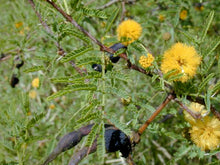|
Scarification: Pour boiling water over seed , let cool in water for 24 hours.
Stratification: none required.
Germination: sow seed 1/4" deep, tamp the soil, mulch the seed bed.
Vachellia farnesiana , previously known as Acacia farnesiana , commonly known as Needle Bush , is so named because of the numerous thorns distributed along its branches. The native range of V. farnesiana is uncertain. While the point of origin is Mexico and Central America the species has a pantropical distribution incorporating Northern Australia and Southern Asia . It remains unclear whether the extra-American distribution is primarily natural or anthropogenic. It is deciduous over part of its range, but evergreen in most locales. The species grows to a height of up to 8 metres (26 ft) and has a life span of about 25–50 years.
An essential oil called Cassie is distilled from the flowers. Cassie absolute is employed in preparation of violet bouquets and is extensively used in European perfumery. Cassie pomades are manufactured in Uttar Pradesh and the Punjab. A deliciously scented essential oil, it has a fragrance of violets. A mature plant 10 years old can yield 9 kg of flowers each year. In a suitable climate, the trees begin to flower from their third year. The perfume is extracted from the flowers in form of concrete or pomade. Macerated flowers are placed in melted purified natural fat and allowed to stand for several hours. They are then replaced by fresh flowers and the process repeated until the fat is saturated with perfume. The fat is then melted, strained and cooled. This constitutes the pomade. Odour is that of violets but more intense. Absolute is prepared by mixing pomade with alcohol (2 - 3 kg to about 4 litres) and allowed to stand for 3 - 4 weeks at about -5°C. The alcohol is then separated and distilled over. The extract obtained is an olive-green liquid with strong odour of cassie flowers. Mature trees can yield about 1 kilo of flowers per year. The bark and the fruit are a source of tannin and used in making dyes and inks. The seedpods contain about 23% tannin. The bark, in combination with iron ores and salts, is used as a black dyestuff. A gummy substance obtained from the young pods is used to mend pottery. A mucilage can be manufactured from the gummy sap. A gum exuding from trunk is considered to be superior to gum arabic in arts. The woody branches are used in India as tooth brushes. In suitable climates the plant is grown as a hedge. The trees have also been used for erosion control in sandy soils. Wood - heavy, hard, durable in the soil, close-grained. Used for fencing posts, agricultural implements, pegs, woodenware etc.
|





